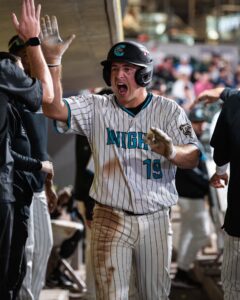Matt Zaleski offers midseason analysis of Charlotte Knights’ staff
I sat down recently with pitching coach Matt Zaleski to assess the Knights’ pitching staff as we approach the All-Star break. Our chat happened to coincide with a noticable change in Knights’ baseball — the games are more competitive! Zaleski explains what’s up.
You’re managing 18 to 20 guys a week. How hard is that?
Well, having experience with it last year is definitely beneficial. We don’t have as many starters as we did last year, which makes it a lot easier for the bullpen guys to continuously get those reps and probably why things are starting to trend in the right direction.
Do you get much or any direction from Chicago? Like, “Pitch Sousa three times this week?”
No, I haven’t this year. Being in the organization as long as I have, we know if a priority guy sits too long and we have to get them in there. But we also don’t want to burn them out because with those 40-man guys, you never know if there could be an injury up there and they are a phone call away. So it’s important from my standpoint to keep them healthy and ready and available as much as possible. By limiting their back-to-backs and multiple-inning outings, they are more likely to be ready to go to Chicago and if they are needed.
So it is little bit easier having fewer starters but that wasn’t by design?
Correct. It’s easier. It definitely is. I mean, you’ve got two or three bullpen guys that can go — well, they all can go two innings — but you’ve got three or four that you kind of designate as multiple-inning guys. So, like a JB Olson will start the game for you and then [Steven] Moyers comes in and handles another part of the lineup, and then you just play one-inning matchups and see where you get to at the end of the ballgame.
And so you do play matchups?
As much as you can. Yeah. You try. Last year was just a new experience with a 20-man pitching staff and trying to get them in games. This year, we have a little more understanding about how to go about this. I talked to Ethan (Katz) about blocking out four hitters that the one-inning relievers are matched up for.
Do you have any reverse righties or lefties, and do you utilize them that way?
Uh, no. It’s not just all lefty/righty. It can be like, Lehigh Valley’s two through five hitters don’t hit lefthanded changeups well. So three of those guys could be righty and we can still bring in a lefty because he has a good changeup and they don’t hit them, so that’s more what it comes down to with matchups.
OK, let’s talk a little bit about the bullpen because it looks like the last two weeks and last night on this new homestand they were really solid.
Yeah, they’ve done a good job. It is tough to look at the season as a whole because we have different guys here from the time we started. Guys have come up from Birmingham and we’ve signed some quality free agents. And then the guys who have been here all year are starting to pick up the pace a little bit.
It could be one of those things where you roll out of spring training into this ballpark and you get shell-shocked — it’s not an easy place to pitch — but you know, you sit down and have conversations with different guys, just trying to get a feel for what makes them tick, trying to understand what is their best approach to hitters and how to get them out. And sometimes it takes a little while to get things rolling.
But you think you’re at that point?
I think so. There’s some things that we’ve changed that I think have helped over the last probably three or four weeks that have limited damage from home runs. I can’t go into the numbers off the top of my head, but I feel like we’ve given up a lot more singles than extra-base hits over the last probably two or three weeks.
Can you share what that change in philosophy is?
No, I can’t. (laughs)
I can’t even imagine. Is it like pitch mix?
A little bit of pitch mix. A little bit of philosophies and like where to go with certain pitches at certain times.
It was kind of like an epiphany when I was sitting, watching a major-league game and things happened in the game and I was like, wow, okay, maybe there’s something to that. And then I looked into the numbers and realized that (that approach is) pretty good.
You picked up a couple of veterans and they seem to be hitting their stride.
[Rafael] Dolis came in and we kind of let him go about his business and how he used to pitch. It was a lot of fastballs. Well, he’s got two, well-above-average off-speed pitches. So we pretty much told the catcher, let’s have him throw those a lot more. He’s still got 94, 95 in the tank, but (the breaking pitches) are something to protect that 94/95. And he’s really done a nice job and has had super-efficient innings, which is nice because he can bounce back quickly.
And Parker (Markel) has big-time stuff, a big 95, 96 fastball and a really good slider/curveball, whatever you want to call it. And then Finnie (Brandon Finnegan) offers like the whole plethora of stuff. He’s a lefty with five different pitches and can use it to attack wherever the hitter’s weakness is. And one of the big things that I think happened for him was just not trying to do too much, just let his stuff play and he’s done a real nice job.
He sounds like he’s a lefty version of Cueto.
Yeah. Pretty much. He matches up to any scouting report, whatever you want. He doesn’t have to have a bucket of hitters that he’s going to face. He can face anybody in the lineup.
So last year, at the end of the year, I asked you who to keep an eye on and you gave me two names and they both made the White Sox out of spring training, [Bennett] Sousa and [Tanner] Banks. So I’m wondering who to keep an eye on the second half down here.
Declan Cronin has a very plus sinker and a good slider to go with it, and he’s 24 years old. He has a very bright future ahead of him. And I think we’re doing some nice things with Lincoln Henzman that could (pay off with) a good second half.
He looks to have a beautiful breaking pitch.
Yeah. He’s doing some nice things. And this is his first year back in two years from pitching (because of injury). He’s just getting into the swing of things in terms of the feeling and the repetition of the delivery and all that … it has been a work in progress, but he’s starting to come along. It’s nice to see.
And [Hunter] Schryver has done a nice job, kind of quietly.
So 20 pitchers seems like a ton of guys to try to help with their mechanics, look at film, look at stats. What is a typical day like for you?
When I get to the field, I watch some video from the night before. If there are some pitches or at bats or some stuff that pique my interest, I circle it on the game chart when I’m keeping track of the pitch count and what’s going on in the game … and then I go back and maybe watch a delivery or see whatever the sequence was that day.
Next, I go into the scouting report, and then (I decide) who needs the most help at that point and that is who I will gravitate to … or if a guy comes and asks me a question, my door is always open.
So you’ll decide who needs the most help and then what do you do? Look at data? Video? Or wait till the guy is having a side session?
The nice thing is that we get the data after every game and it is in my email before I even show up to the ballpark. So I know if someone’s pitch metrics are starting to fluctuate the wrong way. So I know if a particular trend is happening, we need to take care of it. Or if you see it in back-to-back outings and it’s starting to (become an issue), you bring it to their attention, get them on the mound, do some stuff with them and it usually cleans itself up. If it’s a delivery thing, then that takes a little more work — whether it be direction, getting too rotational, all sorts of things — that takes a little more work.
Do you see that in video or do you see that during the game?
I usually see it during the game, but being on the first base side, I can only see so much. Lefties, I can see what’s going on all day. Righties, it is a little more challenging. So, yeah, with righties, I will go back and watch delivery stuff.
John Parke is your one guy who is taking the ball every fifth day. How has he progressed from last year? Has he progressed from last year?
He’s controlling what he can control almost the same as he did last year, like limiting damage, controlling his walks. But he’s just giving up more base hits, which has resulted in more runs and a higher ERA. It was something that we talked about a couple sidelines ago, of just getting back to what he was doing last year. Not so much how to pitch or movement of pitches because his movement hasn’t changed. But maybe create a different attack plan and change some delivery stuff that he went away from in the offseason.
To his credit, he did a lot of nice things in the offseason to try to increase velo and increase a bunch of other stuff. But, from my standpoint, it has taken away from his ability to throw the ball downward and so while the movement is the same, the perceived angles are a little bit different.
So it’s not something as simple as catching a little more of the plate or not getting the ball down?
No. His actually command is actually better this year.
Thanks for your time!






Why does Zalesky’s secret approach to better stats remind me of Hamsterdam?